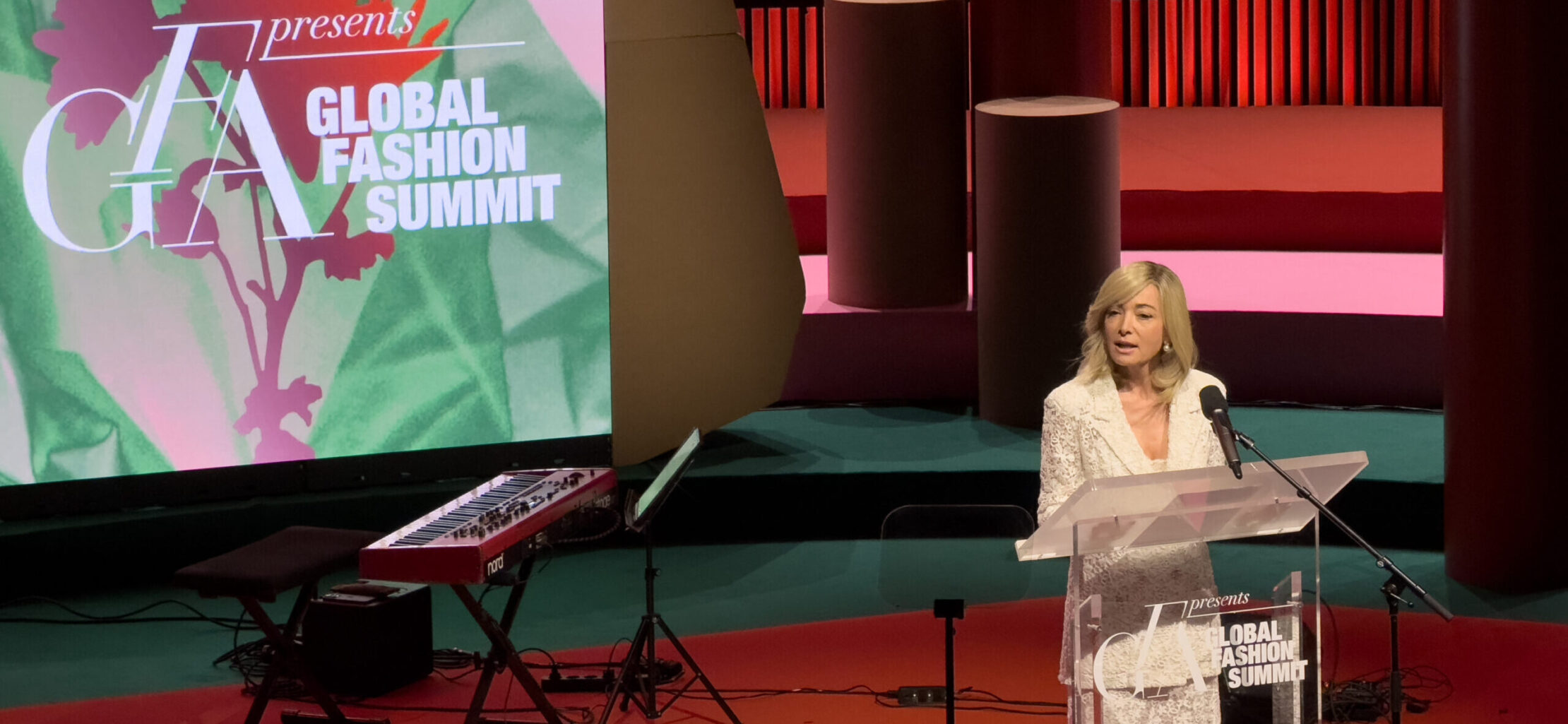The Global Fashion Summit 2025 addressed fashion’s sustainability challenges, focusing on “Barriers and Bridges.” Over 1,000 leaders explored solutions through innovation (AI, material tech), capital (investments), courage, incentives, and regulation. The key takeaway emphasised collaboration across all stakeholders to drive systemic change and build a sustainable fashion ecosystem.
The Global Fashion Summit in Copenhagen gathered over 1,000 industry leaders, innovators, and policymakers to push forward sustainability in one of the world’s most resource-intensive industries. Held at the iconic Copenhagen Concert Hall, the Summit explored the theme of ‘Barriers and Bridges’, focusing on challenges and collaborative solutions in five key areas: Innovation, Capital, Courage, Incentives, and Regulation.
The Summit not only offered insights into fashion’s pressing environmental and social challenges but also provided actionable steps to create sustainable change. Debbie McKeegan, Fespa Textile Ambassador and CEO of Texintel attended the summit. Here’s a closer look at the key insights and takeaways.
Sustainability Challenges in Fashion
The Summit set the stage with sobering statistics about climate change. With 150 extreme weather events in 2024 affecting 3.6 billion people globally, the urgency for sustainable practices couldn’t be more critical. Fashion’s role in this crisis is profound, from its resource-intensive production processes to its rapid consumption cycles.
Federica Marchionni, CEO of Global Fashion Agenda, underscored the importance of the industry adapting to economic and environmental changes. “These are extremely challenging times for sustainability,” she stated, calling attention to both the obstacles and opportunities for transformation within the sector.
The Summit’s theme, ‘Barriers and Bridges’, encapsulated the dual approach necessary for change:
- Barriers: Identifying and confronting challenges like waste management, carbon emissions, and over-reliance on fossil-fuel-based textiles and inefficient manufacturing processes.
- Bridges: Creating pathways through innovation, collaboration, and regulatory frameworks to foster sustainability.
Leadership and Innovation in Sustainability: One of the most compelling aspects of the Summit was its emphasis on leadership and creative solutions. Industry leaders stressed the need for bravery and vision to break down sustainability barriers.
Innovation Forum: The Innovation Forum showcased 30 solution providers offering cutting-edge advancements in sustainable fashion.
Notable examples included:
- AI-Powered Forecasting and Design Tools: These tools are enabling brands to create more precise collections, reducing waste.
- Technology Redefining Materials: Companies pioneering textile-to-textile recycling solutions were highlighted as key players in reducing waste and fostering a circular economy.
The Summit also facilitated over 400 tailored introductions through matchmaking, fostering partnerships between innovators and industry stakeholders.
Collaboration Through Capital and Investments: Speakers highlighted the critical role of capital in scaling sustainable initiatives. Investments are needed to fund promising startups and incentivise established businesses to adopt greener practices.
Leadership Roundtables: The 18 closed-door Leadership Roundtables proved pivotal in driving progress. Discussions on decarbonisation included real-world examples like the renewable energy initiatives in Bangladesh’s garment sector, which provide scalable solutions that could be replicated globally.
Federica Marchionni advocated for increased transparency and collaboration between businesses, investors, and policymakers to encourage bold commitments towards sustainability.
The Role of Policy and Regulation: Regulation emerged as a recurring theme throughout the Summit. Effective policy frameworks can create incentives for businesses to adopt sustainable practices while penalising those that fall short.
Speakers urged industry leaders to actively collaborate with policymakers to design supportive regulatory structures. Discussions also touched on the challenges of navigating a fragmented regulatory landscape, with some nations advancing sustainability-focused policies, while others lag behind or are deregulating.
Key points included:
- Developing uniform global policies to reduce confusion and ensure cohesive progress.
- Encouraging the creation of financial, environmental, and social incentives that make sustainability not just the ethical choice, but the business-smart one.
Courage and Community Spirit: Beyond technical solutions, the Summit embraced a human-centric approach, drawing attention to the role of courage and community spirit in driving change. A session titled ‘Equal Work, Equal Words’ focused on fair labour practices, highlighting the importance of dignity and equality throughout the value chain.
Speakers emphasised that the industry’s transformation will rely on leaders willing to take bold, sometimes risky steps. A call to action urged attendees to become “bridges” themselves, overcoming current challenges and connecting their organisations to a more sustainable future.
Empowering Collaborative Networks: The Global Fashion Summit 2025 showcased a multifaceted approach to sustainability, combining technological innovation, investment, policy reform, and courageous leadership. But the main takeaway? Collaboration is non-negotiable if we want to build a resilient, sustainable fashion sector.
To achieve enduring change, businesses must step up, not only rethinking their environmental impact but also fostering partnerships across sectors and regions.
Achieving sustainability requires a systemic shift, underpinned by measurable goals, transparency, and a commitment to accountability. Businesses must integrate sustainable practices at every stage of the supply chain, from sourcing raw materials to production, logistics, and end-of-life management.
This calls not only for adopting cutting-edge technologies but also for engaging stakeholders at every level—employees, suppliers, policymakers, and consumers. Collaboration between teams, organizations, or individuals from different regions or geographic areas is essential – we must work together to address the global nature of the fashion industry’s impact, ensuring alignment on standards and driving innovation.
By embedding sustainability into their core strategy, businesses can not only mitigate risks but also seize new opportunities, positioning themselves as leaders in an increasingly conscious marketplace.
Together we can Driving Innovation, Transform the Future – and build a Pathway to a Sustainable Fashion Eco-system.
